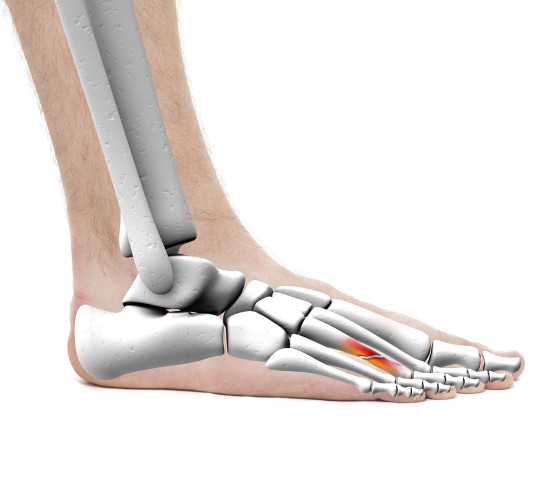Metatarsal bones are the long bones located in our feet between the tarsal (ankle) bones and the phalanges of the toes.
Each foot has five metatarsal bones, which are collectively referred to as the metatarsus, and none of them have individual names.
Metatarsal bones bear much of our weight when we are standing, walking, or running.
Injuries to the metatarsal bones are very common and can happen in a number of ways, but most commonly occur when a heavy object falls on them or when they are twisted during a fall.
There are two types of metatarsal fractures: acute and stress fractures. Acute fractures, also called traumatic fractures, happen instantaneously and are caused by an impact, such as when a heavy object falls on the bones.
Stress fractures are caused by repetitive actions or impacts to the bones. They worsen over time and are sometimes not evident on x-rays until the bone has started to heal. The second, third, and fourth metatarsals are most prone to stress fractures.

Causes of stress fractures to these bones :
Causes of an acute fracture to these bones :
Symptoms of Metatarsal Fracture

Stress fracture symptoms include :
Acute fracture symptoms include :
How Are Metatarsal Fractures Diagnosed ?
X-ray is the basic tool to diagnose metatarsal fracture.
MRI and CT scans are seldom used in these cases since they are more useful when looking for injuries to ligaments and other soft tissue structures.
However, they may be ordered if the circumstances in your case require deeper investigation especially in doubtful stress fracture, or if the x-rays and bone scanners do not detect any obvious injury.
How Are The Metatarsal Bones Treated ?
It’s important to know that treatment methods differ for each metatarsal. If you have injured the second, third, or fourth metatarsal, you will need to get plenty of rest and allow yourself to become immobile for a while.
Recovery periods range from four to eight weeks, depending on the severity of the fracture or break. The most commonly injured metatarsals are the second and the fifth.
Treatment should include RICE method. Rest, Ice, Compression, and Elevation are very important when healing bones in the foot and lower leg.
If you cannot stay off your feet for the period recommended, you may be advised for walking cast or brace to enable mobility. Stiff-soled shoes and/or crutches may also be beneficial to your situation.
If these methods fail, surgery may be considered. If your injury involves multiple breaks or a displaced bone, or if the healing process is not moving forward, you may need a surgical procedure to fix your metatarsal.
How Can you prevent Metatarsal Fractures?
Preventing metatarsal fractures can be tricky, especially if you’re involved in high-impact activities such as sports. If you play football or soccer, foot injuries may be inevitable. However, you can still do things to prevent a significant injury, such as :

